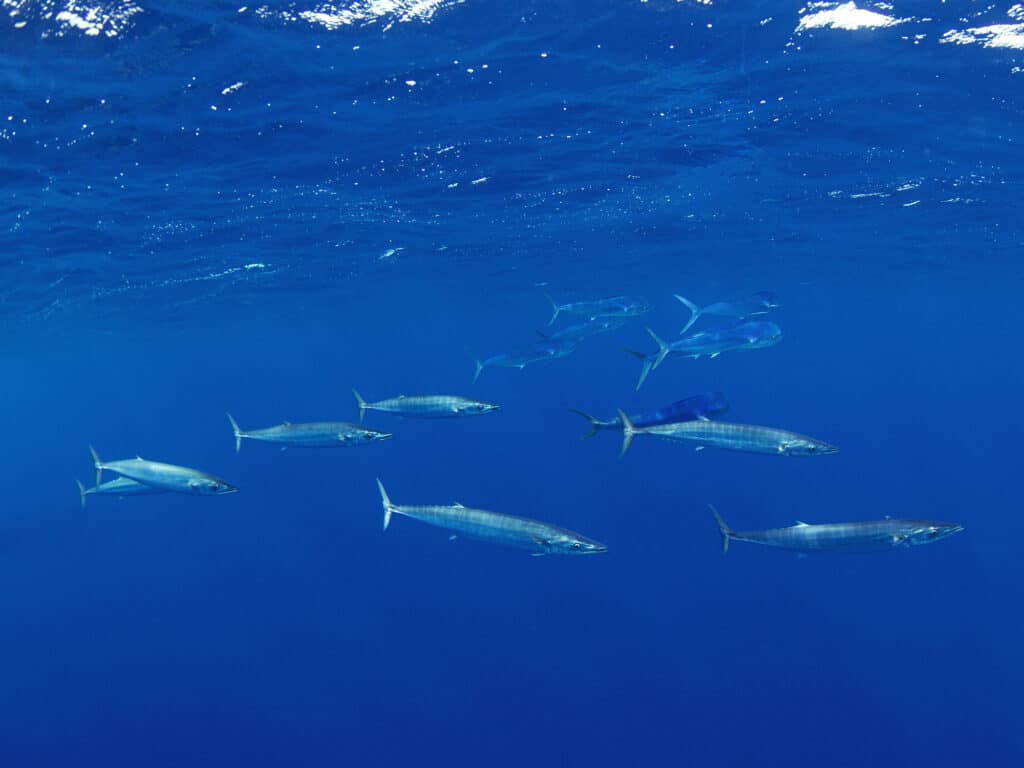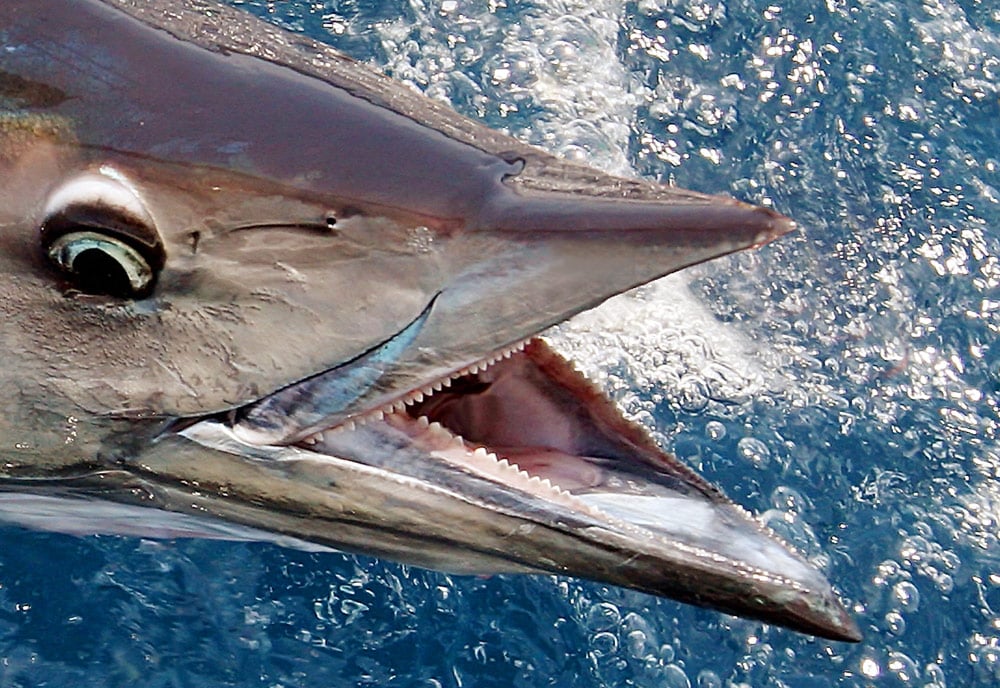
In warm-water locations worldwide, wahoo is predominantly targeted on the troll. While this is one of the most-productive methods to locate and target these gamefish, you tend to miss out on their hard fighting ability and extravagant runs using this method.
Southern California Wahoo Fishing
In Southern California, the long-range charter fleet has been targeting them quite differently for years. They cast to them with “wahoo bombs” and jigs. The methods and range of lures maximize the opportunity of encountering wahoo, often leading to multiple hookups on the boat. In some areas, wahoo really stack up in high numbers. With trolling, you might just get a strike or two when passing through a productive area. Casting to wahoo can be incredibly effective.
The long-range fleet comprises nearly two dozen boats that call San Diego Bay home. Each vessel has been thoughtfully designed as a multi-day fishing machine for anglers. When describing these operations, think of it as hotel meets tasty restaurant meets spacious fishing platform. Trips on these boats can range from just three days to 28 days. The longest trips use the extended period to explore far and reach remote bountiful banks for less-pressured bluefin tuna, yellowfin tuna, wahoo, dorado, yellowtail and more.
Southern California and its long-range boats have a significant history with wahoo (or “skins,” as they are called among the fleet). On these trips — which explore the local banks off SoCal all the way south to Cabo — wahoo is one of the primary fishing targets. While catching wahoo is not a new endeavor, how this fleet targets this delicious gamefish warrants explanation.
Trolling Helps Locate Wahoo

For better or worse, trolling is the most common method to target wahoo worldwide. It’s tough to argue that there is a better method to locating wahoo than trolling. In most cases, this leads to one or two fish being landed per bite. Here’s the important part: Anglers onboard should be ready to cast lures once a wahoo is hooked on the troll. Being ready to cast quickly leads to several more or, at times, a wide-open bite on these toothy critters.
Wahoo are seldomly alone, and usually, they are in schools ranging from just a few fish to dozens of fish. The schooling behavior presents an opportunity to maximize fish-catching after a troll hook-up. On these head boats, trolling Braud Marauders, Yo-Zuri Bonitas, Nomad MadMacs or diving lures are used to locate a school.
When to Cast Lures for Wahoo
Once a hook-up occurs, the deckhand at the bait tank entices the rest of the fish to stick around by tossing out some baits. Once the baitfish start flying, so do the lures. At this point, anglers will begin casting their wahoo bombs or other assortment of wahoo lures during what’s called “the slide.” The slide is when the boat is still in motion but slowing, eventually sliding to a stop. The overabundance of lures, bait, and hooked fish often turns wahoo aggressive, resulting in a feeding frenzy.
This style of fishing, at times, can be best described as controlled chaos. There is nothing like hooking a wahoo on a jig (often called an “iron”) or wahoo bomb. The sudden stopping of your jig at the hook-up, your line racing across the water’s surface faster than you’ve ever seen it. It’s truly an unforgettable experience. At times, these wahoo-feeding frenzies get so aggressive that they’ll strike just about anything you cast in front of them.
The Best Lures to Cast for Wahoo

Ideally, when casting to wahoo, you want you’re lure to have specific characteristics:
- Castability: Your lure needs to be heavy enough to give you the ability to make a significant cast as the boat is sliding. Most wahoo bombs and jigs are in the 2- to 4-ounce range.
- Speed: Wahoo are speed demons, and you need to be able to have a lure that matches their speed. You should be able to retrieve this lure at a very fast retrieve. A tight wiggle is all you need out of your lure.
- Hooks: Rig with the sharpest hooks available. Think your hook is sharp? Sharpen it even more. These fish have tough boney mouths, making penetrating their jaw difficult.
- Sink: You need a lure that will sink down after casting out. The urge is to cast then retrieve immediately, but I can tell you’ll double the number of strikes by letting your lure sink 30 to 50 feet down before retrieving.
- Color: While the verdict is out, and every angler will give you a different opinion, it’s common to have blacks and dark colors against fluorescent colors. Blacks and pinks are great for wahoo.
- Tip: When selecting lures to cast at wahoo, don’t limit yourself to wahoo bombs and jigs. Take the descriptors above; if it applies to your lures, try it. Stick baits have also been a successful option in recent years.
What Tackle to Use for Wahoo

As you guessed, conventional tackle is the go-to option on the Pacific Coast. Today, we can access fantastic gear from various manufacturers with this fishing style in mind. Ideally, it would help to have a rod with substantial stopping power and a reasonably soft tip to allow load up when casting and hooking up.
A 7-foot, 6-inch to 8-foot rod with a “Heavy” or “Extra Heavy” rating usually does the trick. As for your reel, there are so many options available today. The three primary descriptors would be: (1) the ability to cast far, (2) stopping power (meaning high drag capability), and (3) high speed retrieve (meaning the ability to crank your lure fast!). Many anglers tuned into this fishery rely on reels with taller spools to increase their retrieval rate and add an oversize handle.
The addition of oversized saltwater baitcasting-style reels has also been a great bonus to this fishery. The reels are fished using 50- to 60-pound braid, connected to a monofilament or fluorocarbon leader.
Should Anglers Use Wire for Wahoo?
To use wire or not to use wire? That is a common question. Wahoo can sometimes be finicky. Presenting your lure without wire can significantly increase the number of hook-ups. At the same time, be ready to lose several jigs to those razor-sharp teeth. Single-strand wire is preferred if you intend to use wire, as it’s much stealthier than multi-strand wire. The recommendation is a simple haywire twist connection on single-strand, 60- to 90-pound wire.
Tips for Casting to Wahoo

- Biting near the boat. When pulling your lure out of the water, have it come to a complete stop, then lift. More than once, I have seen lures get bit as an angler pulls a jig out of the water during their last retrieve, surprising the angler and resulting in a rod and reel overboard.
- Wear close-toed shoes. Please wear boots or shoes when fishing for wahoo. Nothing is scarier than a wahoo flopping on deck with bare feet in proximity.
- Watch out for flying objects. Keep your eyes peeled for flying wahoo. Another crazy scenario I’ve seen several times on a wahoo bite. Wahoo will often fly out of the water in pursuit of their prey just inches from the boat.
- Try casting for wahoo anywhere you fish. While the method of casting to wahoo on a troll stop is a West Coast method, make sure to experiment with this in your wahoo fishery as it’s sure to put some on the deck. There’s no reason jigs and wahoo bombs wouldn’t work in other wahoo hotspots such as Bermuda, Bahamas or even far offshore Louisiana.








